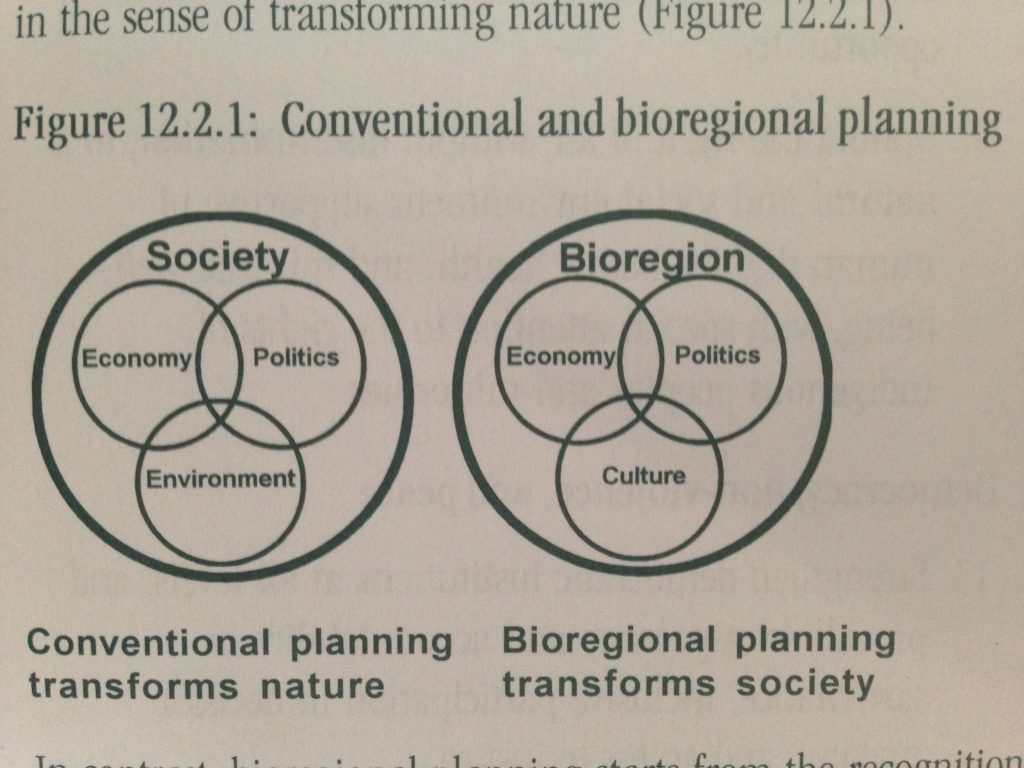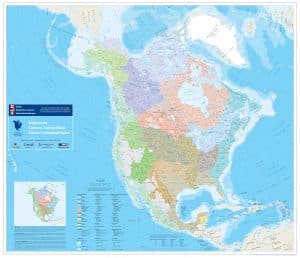Introduction
Bioregionalism is a vision of a future that works for people and for the Earth.
“There’s little natural about the boundaries that divide states and countries. They’re often imaginary lines that result from history, conflict, or negotiation. But imagine what the world would look like if borders were set according to ecological and cultural boundaries.”
– Raye Stoeve
Bioregionalism reflects perhaps one of the most important, yet least known or understood philosophies that may exist today.
At it’s core – bioregionalism simply seeks to ground movements, ideas, activities, economies, politics – into these places, with a strong ethic that values responsibility and accountability. We start with our watersheds to reinhabit our bioregions and connect with indigenous ways of living and knowledge that has grown from them. Once learned, bioregionalism provides a unifying set of principles and organizing methodology, and is a powerful tool for breaking down large, urgent global issues, and creating simple, accessible pathways for action and change.
Bioregionalism means living indigenous to place. Despite the intentional erasure of cultures living for centuries outside of a colonial or capitalist lens of extraction based economy, the majority of human history has been bioregional. In western schools of thought, Bioregionalism has emerged as a movement, an ethic and idea that has been growing for more than four decades which seeks use natural features such as mountain ranges, and rivers as the basis for administrative units, recognizing place based technologies, ways of living and cultures that stem from, and are rooted from place – rather than arbitrary lines on a map.
Bioregionalism acts in two ways:
-
Short Term & Pragmatic. Works within our system to adopt policies and changes that move us in the right direction of bioregionalism, and away from systems which are actively harming our planet and communities
-
Long Term & Visionary. Works outside of our system in ways that are utopian, visionary and long term.
Bioregionalism is an age-old way of viewing the world. Regions are not delineated by imaginary, straight lines as scribed by humans, but by the climate and land forms which make that part of the planet uniquely distinct. Local life-forms, cultures, traditions and hopes for the future reflect that particular place on the planet in which they’re rooted.
Using these features, it seeks to reign in extractive economic policies, create regenerative cultures that ensure ethical, local and sustainable means of production, and to better and reconnect the livelihood of inhabitants by living responsibly within the limits of place. Taken together, it is a political, cultural, and ecological set of views based on naturally defined areas called bioregions. Deconstructing and breaking down borders which are arbitrary, toxic and non-representative to our place and inhabitants is one of the chief priorities of bioregionalism.
From two pioneers of bioregionalism, Peter Berg & Raymond Dasmann bioregions exist as bio-cultural regions that are “a geographical terrain and a terrain of consciousness—to a place and the ideas that have developed about how to live in that place” with particular attributes of flora, fauna, water, climate, soils, and landforms, and by the “human settlements and cultures those attributes have given rise to.” From this gives rise to the idea of bioregionalism – administrative units based around watersheds rather than arbitrary lines on a map, and local cultures that grow using lessons and in balance with the natural ecosystems they inhabit, and that will be different for every specific geographic areas.
A key principle in bioregionalism is reinhabitation, which means building healthier ways of living that are responsible, ethical, that not only maintain but regenerative our local ecosystems, and working with our natural ecosystems, aligning human activity with our bioregions, rather than for human habitation.
This is both on a societal level, and a personal one – which starts with every person developing a sense of place. Of rooting ourselves into the history, the things that make each region special – the plants, the animals, the types of soils, the mountains and rivers. How things change over time – why different areas get different rainfall – and how agriculture, energy production, buildings can all best tie into that in well thought out ways.
For each of us, it means taking the time to root in and learn the possibilities of place. It is mindfulness of local environment, history, and community aspirations that lead to a sustainable future. It relies on safe and renewable sources of food and energy. It ensures employment by supplying a rich diversity of services within the community, by recycling our resources, and by exchanging prudent surpluses with other regions. Bioregionalism is working to satisfy basic needs locally, such as education, health care, and self-government.
Simply put, [bioregionalism] means learning to become native to place, fitting ourselves to a particular place, not fitting a place to our pre-determined tastes. It is living within the limits and the gifts provided by a place, creating a way of life that can be passed on to future generations.
—Judith Plant
What is a Bioregional Movement?
Bioregional movements work to connect these to ideas together. To shift our borders, governing models, and ways of living from non-bioregional ones – to bioregional ones. One government, or nation, or many governments and nations doesn’t ultimately matter, so much as every community large or small, that is impacted by a decision has a voice in that matter.
Bioregionalism is, at it roots it is a way to restructure society to work within each given region and place, rather than transforming each to human needs.
“Bioregionalism emerges as a response to the formidable power relations of global political economy and the ensuing fragmentation of place. It seeks to integrate ecological and cultural affiliations within the framework of a place-based sensibility, derived from landscape, ecosystem, watershed, indigenous culture, local community knowledge, environmental history, climate and geography. More than an alternative framework for governance or a decentralized approach to political ecology, it represents a profound cultural vision addressing moral, aesthetic and spiritual concerns. In effect, bioregionalism seeks to penetrate, inform and reinhabit the interstices of contemporary political economy, turning states and countries into biomes and watersheds, changing not only the boundaries of governance, but the boundaries of perception as well. Indeed, the reinhabitation of landscape is fundamentally a challenge of perception as well as citizenship.”
– Mitchell Thomashow
Bioregional ways of living and cultures are anywhere where culture is regenerative, fitting within natural borders and embedded as part of its environment, rather than trying to make our environment bend to human needs. Bioregionalism stresses that the determination of a bioregion is also a cultural phenomenon, and emphasizes local populations, knowledge, and solutions. It is both societal, but also deeply personal.
What is a Bioregion?
Bioregions are natural countries of the planet. Their edges are hard and jagged – fault lines, mountain ranges, while the ecoreginos within them tend to blend and merge together and only emerge by studying many layers that only when taken together can paint a whole picture. They are the largest sense of scale in which physical connections make sense. They may contain within them many nations, communities, inhabitants, and ecosystems. A bioregions’ environmental components (geography, climate, plant life, animal life, etc.) directly influence ways for human communities to act and interact with each other which are, in turn, optimal for those communities to thrive in their environment. As such, those ways to thrive in their totality—be they economic, cultural, spiritual, or political—will be distinctive in some capacity as being a product of their bioregional environment.
Bioregionalism recognizes, nurtures, sustains, and celebrates our local connections with:
- Land
- Plants and Animals
- Springs, Rivers, Lakes, Groundwater, & Oceans
- Air
- Families, Friends, Neighbors
- Community
- Native Traditions, Ways of Living & Sovereignty
- Circular and Place Based Systems of Production & Trade
- Celebrating the diversity of each place.
The bioregional perspective recreates a widely-shared sense of regional identity founded upon a renewed critical awareness of and respect for the integrity of our ecological communities.
People are joining with their neighbors to discuss ways we can work together to:
- Learn what our special local resources are
- Break down global issues to a local level
- Research alternative frameworks based on natural borders and boundaries more representative of people, inhabitant and place.
- Deconstruct colonial and non-representative frameworks.
- Assign concrete metrics for success, including carbon emissions and sequestration.
- Plan how to best protect and use those natural and cultural resources
- Exchange our time and energy to best meet our daily and long-term needs
- Enrich ours and future generations local and planetary knowledge
Key Policy Points:
-
Develop and use a bioregional framework for decision making.
-
Take into account cultural and ecological realities such as watersheds, fire sheds, fiber sheds, food sheds, air sheds, growth management, transportation, urban planning.
-
Use data driven and peer reviewed information that is transparently funded.
-
Watershed administrative districts and commons.
-
Let natural borders and cultural realities help define political administration.
-
Every community impacted by a decision deserves to be a part of that decision.
-
Culture stems from place. Different areas will have different needs based on the realities of that place.
-
Explore place appropriate technologies and indigenous ways of living.
-
Use a bioregional assessment model for carrying capacities in each region and to develop benchmarks for emissions and growth.
-
Support economic systems which are local, sustainable and ethical.
Goal of Bioregionalism:

Bioregionalism seeks to organize economic, political and cultures (lifestyles) to fit within bioregions, and to build interconnected administrative systems within each.
- Politically – Decentralize & rethink political boundaries to shared cultural, physical and geographic realities that can better represent people, inhabitants and place. Embraces consensual relationships, dynamic and fluid borders for how people want to live and how data interelates with each other, set within bioregional realities. We seek to shift boundaries and borders within watershed governances.
- Culturally – Support and embrace lifestyles customized for each bioregion, using indigenous ways of living, knowledge and resources. Understand the historic, cultural and economic history and context of each area and place to develop highly specialized ways of living custom fit for each area community.
- Economically – To create bioregional frameworks for a regenerative economy that is local and sustainable, connected globally in a way that is ethical and accountable, and that puts more back in than it takes out, improves the well being of the place itself over generations. Use the bioregion as a framework to create measurable outcomes and benchmark to determine metrics for success or failure.


